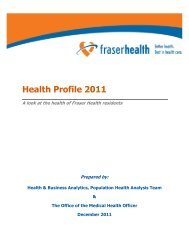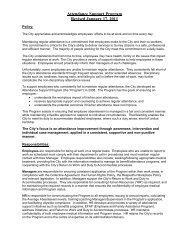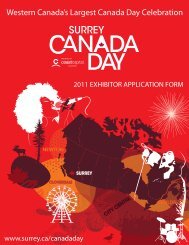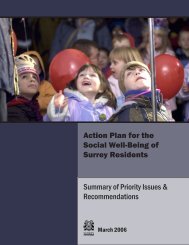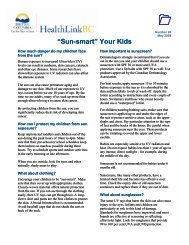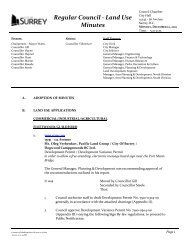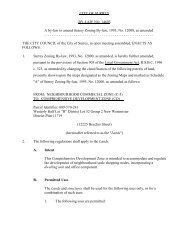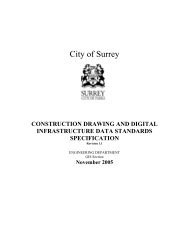Blackie Spit Park: Wildlife Habitat Enhancement Plan - City of Surrey
Blackie Spit Park: Wildlife Habitat Enhancement Plan - City of Surrey
Blackie Spit Park: Wildlife Habitat Enhancement Plan - City of Surrey
Create successful ePaper yourself
Turn your PDF publications into a flip-book with our unique Google optimized e-Paper software.
Management Unit 14: <strong>Blackie</strong> <strong>Spit</strong><br />
1.0 Existing Conditions<br />
The spit, Management Unit 14, has four main habitat types, three <strong>of</strong> which are mapped in<br />
Drawing 11. Those types include a dense forb/shrub community at the base; the sparse short<br />
grass/forb community comprising about half the spit and located on the inner half; a denser forb<br />
community located primarily on the outer and south parts <strong>of</strong> the spit; and the bare sand beach areas<br />
with an upper intermittent fringe <strong>of</strong> dunegrass (Elymus mollis) at the tip <strong>of</strong> the spit and around parts<br />
<strong>of</strong> the north and south sides (Figure 39).<br />
The dense forb/shrub community at the south east base <strong>of</strong> the spit, consists <strong>of</strong> goldenrod, sweet pea<br />
(Lathyrus sp.), reed canarygrass, tansy, two thistle species, American searocket (Cakile edentula),<br />
and woody vegetation such as snowberry and small introduced fruit trees. It also has the invasive,<br />
daphne.<br />
The drier grass/forb community <strong>of</strong> the inner half <strong>of</strong> the spit consists <strong>of</strong> low-growing grasses, plantain,<br />
and yarrow, with American searocket in some areas. Occasional broom plants occur in that area, and<br />
individual small trees (alder or Pacific crabapple) and small blackberry clumps occur (Figure 40).<br />
The denser vegetation community <strong>of</strong> the outer half <strong>of</strong> the spit (Figure 41) contains species such as<br />
American searocket (Figure 42), silver burweed (Ambrosia chamissionis) (Figure 43), orache,<br />
yarrow, sweet clover, a species <strong>of</strong> vetch (Vicia sp.) and other species.<br />
2.0 Goals and Objectives<br />
Species Management Goal<br />
• Migratory open-habitat passerines (e.g. horned larks, snow buntings, Lapland longspurs, pipits,<br />
sparrows, finches).<br />
<strong>Habitat</strong> Management Objectives<br />
• Maintain existing open nature <strong>of</strong> spit with herbaceous vegetation:<br />
• Establish islands <strong>of</strong> low-growing native shrubs and trees in pre-established locations to<br />
provide escape cover for sparrows and finches using the site;<br />
• Control invasive species (non native and all other unwanted woody species);<br />
• To avoid unnecessary disturbance to birds using estuary and spit, and in accordance with the<br />
master plan:<br />
• confine people to 2 trails: a major central trail and a minor south trail. The existing south<br />
trail should be moved 2 m above the high tide line and provide an optional route for people<br />
without dogs;<br />
• Establish destination feature and viewing area at new trail end;<br />
• Move existing north-facing benches to the central trail edge.<br />
<strong>Blackie</strong> <strong>Spit</strong> <strong>Park</strong>: <strong>Wildlife</strong> <strong>Habitat</strong> <strong>Enhancement</strong> <strong>Plan</strong> – Management Unit 14 67



